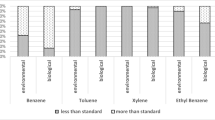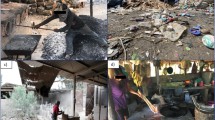Abstract
Exposure to volatile organic compounds (VOCs) can cause cancers in human. This study aimed to measure the concentration of four VOCs including benzene, styrene, ethylbenzene, and phenol in ambient air of a petrochemical complex in Iran. Also, their urinary metabolites including phenol, mandelic acid (MA), and phenylglyoxylic acid (PGA) in the workers were monitored. Urine samples were collected before and after the 8-h workshift according to the NIOSH methods. They were analyzed by a gas chromatograph coupled with a flame ionization detector (GC-FID). High levels of the ambient VOCs were detected in the units of recovery and olefin. The levels of ethylbenzene and phenol were less than the guidelines suggested by NIOSH and ACGIH. However, in some cases, the amounts of benzene and styrene were higher than the guidelines. Excellent positive correlations were observed between VOCs exposure and their urinary metabolites (r 2 > 0.90), except for benzene (r 2 = 0.26). Our finding verified that urinary biomarkers can be applied as bioindicators for ambient exposure to VOCs. There is a risk of exposure to high levels of the pollutants in some of the sites, and it is necessary to adopt some preventive measures to reduce health risk.

Similar content being viewed by others
Notes
National Institute for Occupational Safety and Health
American Conference of Governmental Industrial Hygienists
Occupational Safety and Health Administration
References
Al Zabadi H, Ferrari L, Sari-Minodier I, Kerautret M-A, Tiberguent A, Paris C, Zmirou-Navier D (2011) Integrated exposure assessment of sewage workers to genotoxicants: an urinary biomarker approach and oxidative stress evaluation. Environ Health 10(1):23. https://doi.org/10.1186/1476-069X-10-23
ASTM (2010) Standard Guide for Selection of Methods for Active, Integrative Sampling of Volatile Organic Compounds in Air, ASTM D6345–10, West Conshohocken, www.astm.org
ATSDR (2007) Toxicological Profile for Benzene. US Department of Health and Human Services, Agency for Toxic Substances and Disease Registry, Atlanta
ATSDR (2010) Toxicological Profile for Ethylbenzene,. US Department of Health and Human Services, Agency for Toxic Substances and Disease Registry, Atlanta
Bahrami A, Jonidi-Jafari A, Folladi B, Mahjub H, Sadri Q, Zadeh MM (2005) Comparison of urinary O-cresol and hippuric acid in drivers, gasoline station workers and painters exposed to toluene in west of Iran. Pak J Biol Sci 8:1001–1005
Balaji S, Murugesan A (2010) Assessment of volatile organic compound (VOC) emissions from a petrochemical industry in Ranipet, South India. J Environ Res Dev 4
Blackman WC Jr (2001) Basic hazardous waste management. CRC Press. https://doi.org/10.1201/9781420032604
Boeglin ML, Wessels D, Henshel D (2006) An investigation of the relationship between air emissions of volatile organic compounds and the incidence of cancer in Indiana counties. Environ Res 100(2):242–254. https://doi.org/10.1016/j.envres.2005.04.004
Cetin E, Odabasi M, Seyfioglu R (2003) Ambient volatile organic compound (VOC) concentrations around a petrochemical complex and a petroleum refinery. Sci Total Environ 312(1-3):103–112. https://doi.org/10.1016/S0048-9697(03)00197-9
Chen X, Qian W, Kong L, Xiong Y, Tian S (2015) Performance of a suspended biofilter as a new bioreactor for removal of toluene. Biochem Eng J 98:56–62. https://doi.org/10.1016/j.bej.2015.02.025
Clayton G (1981) CLAYTON FE-Patty’s industrial hygiene and toxicology, vol 2B, 3rd edn. Wiley Interscience, New York
Cosnier F, Nunge H, Cossec B, Gaté L (2012) Simultaneous determination of aromatic acid metabolites of styrene and styrene-oxide in rat urine by gas chromatography–flame ionization detection. J Anal Toxicol 36(5):312–318. https://doi.org/10.1093/jat/bks015
Crawford J (2008) Toxicological profile for phenol US department of health and human services. Public health service agency for toxic substances and disease registry
De Nevers N (2010) Air pollution control engineering. Waveland Press
Deck D, Winston L, Katzung B, Masters S, Trevor A (2012) Basic & clinical pharmacology. McGraw-Hill Medical
Elbir T, Cetin B, Cetin E, Bayram A, Odabasi M (2007) Characterization of volatile organic compounds (VOCs) and their sources in the air of Izmir, Turkey. Environ Monit Assess 133(1-3):149–160. https://doi.org/10.1007/s10661-006-9568-z
Eller PM (1994) NIOSH manual of analytical methods, Fourth Edition, 94. DIANE Publishing
Fishbeck W, Langner R, Kociba R (1975) Elevated urinary phenol levels not related to benzene exposure. Am Ind Hyg Assoc J 36(11):820–824. https://doi.org/10.1080/0002889758507348
Fonger GC, Hakkinen P, Jordan S, Publicker S (2014) The National Library of Medicine’s (NLM) Hazardous Substances Data Bank (HSDB): background, recent enhancements and future plans. Toxicology 325:209–216. https://doi.org/10.1016/j.tox.2014.09.003
Gibson GG, Skett P (2001) Introduction to drug metabolism. Nelson Thornes
Guest M (1997) Styrene copolymers. Handbook of Thermoplastics. Marcel! Dekker, Inc, P. O. Box 5005, Monticello, NY 12701-5185, USA, 1997., 161–175
Hassan AA, Sorial GA (2010) A comparative study for destruction of n-hexane in trickle bed air biofilters. Chem Eng J 162(1):227–233. https://doi.org/10.1016/j.cej.2010.05.034
Hoffmann A, Krumbiegel P, Richter T, Richter M, Röder S, Rolle-Kampczyk U, Herbarth O (2014) Helicobacter pylori prevalence in children influenced by non-specific antibiotic treatments. Cent Eur J Public Health 22:48
IARC (1985) Monographs on the evaluation of the carcinogenic risk of chemicals to humans, v. 35: Polynuclear aromatic compounds, pt. 4: Bitumens, coal-tars and derived products, shale-oils and soots. International Agency for Research on Cancer
IARC (2002) International Agency for Research on Cancer (IARC) handbooks of cancer prevention, 6. The Agency
IARC. (2009) Overall evaluations of carcinogenicity to humans: As evaluated in IARC Monographs volumes 1–82 (at total of 900 agents, mixtures and exposures)[Internet]. Lyon, France: IARC; 2004 [citada el 7 de julio 2009]
IARC, WHO (2000) Some industrial chemicals, 77. World Health Organization, International Agency for Research on Cancer
IARC, WHO (2002) Some traditional herbal medicines, some mycotoxins, naphthalene and styrene. World Health Organization
Lee S, Chiu M, Ho K, Zou S, Wang X (2002) Volatile organic compounds (VOCs) in urban atmosphere of Hong Kong. Chemosphere 48(3):375–382. https://doi.org/10.1016/S0045-6535(02)00040-1
Mammadova S (2013) Assessment of pollution of the atmospheric air in the cities of Azerbaijan. J Agric Environ Sci 2:15–25
Manini P, Buzio L, Andreoli R, Goldoni M, Bergamaschi E, Jakubowski M, Vodicka P, Hirvonen A, Mutti A (2003) Assessment of biotransformation of the arene moiety of styrene in volunteers and occupationally exposed workers. Toxicol Appl Pharmacol 189(3):160–169. https://doi.org/10.1016/S0041-008X(03)00124-8
Michałowicz J, Duda W (2007) Phenols—sources and toxicity. Pol J Environ Stud 16:347–362
Neal AB, Loehr RC (2000) Use of biofilters and suspended-growth reactors to treat VOCs. Waste Manag 20(1):59–68. https://doi.org/10.1016/S0956-053X(99)00297-4
NTP (2011) National Toxicology Program, 12th Report on Carcinogens. US Dept. of Health and Human Services, Public Health Service
Organization WH (2014) WHO Guidelines for indoor air quality: selected pollutants. 2010. ISBN 97892, 89002134
Pistonesi MF, Di Nezio MS, Centurión ME, Palomeque ME, Lista AG, Band BSF (2006) Determination of phenol, resorcinol and hydroquinone in air samples by synchronous fluorescence using partial least-squares (PLS). Talanta 69(5):1265–1268. https://doi.org/10.1016/j.talanta.2005.12.050
Rahimpoor R, Bahrami A, Assari M, Ghorbani F, Negahban A (2015) Biological monitoring of petrochemical industry workers exposed to benzene, toluene, xylenes, methyl ethyl ketone, and phenol in Southern Iran
Sams C, Loizou GD, Cocker J, Lennard MS (2004) Metabolism of ethylbenzene by human liver microsomes and recombinant human cytochrome P450s (CYP). Toxicol Lett 147(3):253–260. https://doi.org/10.1016/j.toxlet.2003.11.010
Shiraishi N (2006) Levels of formaldehyde, phenol and ethanol in dissection room air and measures for reduction. Jpn J Occup Med Traumatol 54:1–10
Slorach SA (1991) Measurement of metabolites as indicators of exposure to chemicals. Methods for assessing exposure of human and non-human biota 5, 323
Smith MT (2010) Advances in understanding benzene health effects and susceptibility. Annu Rev Public Health 31(1):133–148. https://doi.org/10.1146/annurev.publhealth.012809.103646
Sulfide H (2001) Documentation of the Threshold Limit Values and Biological Exposure Indices. American Conference of Governmental Industrial Hygienists, Inc., Cincinnati
Sun H, Trabue SL, Scoggin K, Jackson WA, Pan Y, Zhao Y, Malkina IL, Koziel JA, Mitloehner FM (2008) Alcohol, volatile fatty acid, phenol, and methane emissions from dairy cows and fresh manure. J Environ Qual 37(2):615–622. https://doi.org/10.2134/jeq2007.0357
Tiwari V, Hanai Y, Masunaga S (2010) Ambient levels of volatile organic compounds in the vicinity of petrochemical industrial area of Yokohama, Japan. Air Qual Atmos Health 3(2):65–75. https://doi.org/10.1007/s11869-009-0052-0
US-DHHS (2010) Toxicological profile for styrene. Atlanta: Agency for Toxic Substances and Disease Registry, US Department of Health and Human Services, 1–236
WHO (2014a) 7 million premature deaths annually linked to air pollution. World Health Organization. (http://www.who.int/mediacentre/news/releases/2014/air-pollution/en/)
WHO (2014b) Guidelines for indoor air quality: selected pollutants. World Health organization ISBN 97892, 89002134
Acknowledgments
The authors would like to thank the Research and Development Office of the Petrochemical Company, Iran, for the financial support of the project. Also, Tehran University of Medical Sciences, Department of Environmental Health is acknowledged for analytical assistances.
Author information
Authors and Affiliations
Corresponding author
Additional information
Responsible editor: Philippe Garrigues
Rights and permissions
About this article
Cite this article
Hajizadeh, Y., Teiri, H., Nazmara, S. et al. Environmental and biological monitoring of exposures to VOCs in a petrochemical complex in Iran. Environ Sci Pollut Res 25, 6656–6667 (2018). https://doi.org/10.1007/s11356-017-1045-4
Received:
Accepted:
Published:
Issue Date:
DOI: https://doi.org/10.1007/s11356-017-1045-4




